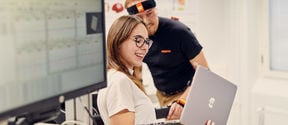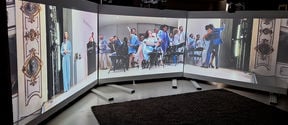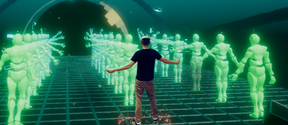Everyday choices: Ayush Bharti, can AI fix a dropped Wi-Fi connection?

What are you, a computer scientist, a data scientist or a statistician?
I’m an engineer by background and did my PhD in wireless communications at Aalborg University. Through my PhD, I gravitated to machine learning, especially the maths and statistics behind the methods that we use, rather than applications.
Now at the Finnish Center for Artificial Intelligence, FCAI, I’m changing fields towards artificial intelligence and machine learning. So, I have one foot in signal processing and one in computer science.
You research simulator-based inference. Can you unpack what that means?
Think of the Wi-Fi router at the office or your home. It’s talking to a phone or laptop that is receiving signals. The environment where this communication happens, be it a small room or a big hall, affects how the signal travels. You may have noticed that GPS is less accurate between buildings compared to open spaces. If the receiver, like your phone, doesn’t account for environmental obstacles, you will get dropped calls or a poor signal. So, what communication engineers do is model, or simulate, how the environment affects signals.
On an old radio, you would turn a knob to get better reception. Similarly, we tune a model to simulate the real world as closely as possible, only we have a lot more knobs. The inference part is getting to know these knobs, which we call parameters. As simulators tend to be complex, it is not possible to tune their parameters with traditional techniques. This is why I develop methods that can help tune simulator parameters to achieve good signal strength in any environment, with any device. AI can assist in this tuning process.
So precise simulation of rooms or environments is the key to better Wi-Fi?
Yes and no. Some models need to know where every table and chair is placed, but they are difficult to apply to different environments quickly. Wireless communication works well, from the cordless mouse in your office to Mars rovers, so obviously we don’t need to know exactly how each environment is structured. In these cases, the models operate on randomness, and that’s also the kind of model I use.
My methods aren’t even specific to wireless communications; they actually come from population genetics and evolution studies, where they want to simulate how populations shrink and grow, for example. In every field, you try to make models, because you can’t collect data on all environments. And in the case of wireless signals, your laptop and phone have tech built on these models, telling them how to recover information that was sent. Unfortunately, signal interference still happens due to reasons other than environmental obstacles!
Switching gears from research: on the day of our conversation, it is extremely snowy. Which do you prefer, the Nordic climate or that of your native India?
Not India’s, with the sweaty feeling! I’ve spent six-and-a-half years in Denmark and Finland, so I’m used to the winter. Slush and freezing ice, that is annoying. But in India, you have summer nine months of the year, you go outside and get tired just from sweating.
In India, it’s so hot all the time, we don’t associate summer with a lot of excitement. In Europe, all the plans revolve around summer. When you see the sun for only two months a year, it feels special. There is this fascination with sun here that does not happen in India. So even though I am happy when the sun comes out here, I still can't simulate the same excitement for it as most Europeans do.
This article has been published in the Aalto University Magazine issue 30 (issuu.com), April 2022.
- Published:
- Updated:
Read more news

Health Technology Engineering equips students to create innovative technical solutions to health challenges
New Master’s programme combines engineering knowledge with practical understanding of health-related issues
Get to know us: Assistant Professor Ville Miikkulainen
Miikkulainen most recently worked as University Lecturer at Aalto University.
Open demo-day in DAVE of Aalto Behavioral Laboratory
Open house event for Dynamic Audio Visual Environment of Aalto Behavioral Laboratory on 7th of May 2024, 13:00-16:00